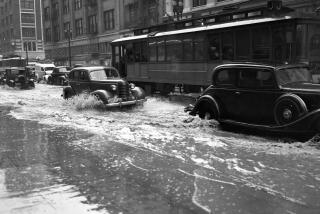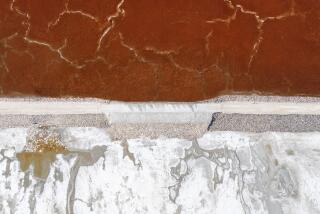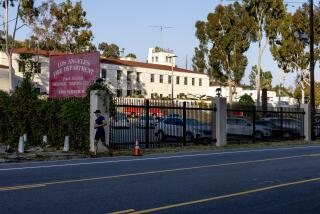Backyard Volunteers : Novices Hold Cold Facts on Weather
CROSBY, N.D. â Each night about supper time--be it rain or sleet or, all too often, mind-numbing arctic cold--John Andrist trudges out behind his house in this wind-swept hamlet six miles from the Canadian border and performs an unsung ritual of vital importance to farmers, lawyers, building contractors, insurance agents, scientists, vacationers and millions of other Americans.
He takes the temperature.
Not just any temperature, mind you. The temperature. Conditions warranting, he also measures the rainfall or the snowpack and throws in the subterranean soil thermometer readings to boot.
Andrist, 55, is the governmentâs official weather watcher for Divide County, one of nearly 12,000 such observers across the country who make up the largest brigade of unpaid volunteers in federal service.
Detail From Amateurs
Todayâs meteorologists may use satellites, radar and other high-tech gadgets to prepare their forecasts. But the detail verifying the five-inch gully washers, 20-below blizzards and even bright, pleasant days that follow the forecasts comes largely from backyard amateurs like Andrist.
Using unsophisticated, sometimes century-old government-issue instruments, volunteer observers gather the bulk of the data used to chronicle the history of the nationâs climate.
âThese observers are the guts of the Weather Service,â said Vernon J. Roller, the National Weather Service official who supervises North Dakotaâs 230 volunteers. âWe couldnât function without them.â
To make his readings, Andrist, publisher of the newspaper in this community of 1,400, must sometimes creep into subzero chills that have been known to send the needle on his alcohol-filled minimum temperature indicator beneath the 40-below mark.
Cold Job
While neighbors rest before cozy fires, he wraps up in his parka, grabs a flashlight and plods 100 feet across his snowy backyard to the spot by the propane tank where his weather recording instruments are latched inside a shelter resembling an overgrown birdhouse.
He checks the minimum temperature gauge, tilts it to reset it, notes the reading on the mercury-filled maximum temperature indicator and then spins it like a dial to shake it down. He also checks soil temperatures on a meter connected to underground probes. And, if any new snow has collected in the bucket alongside the shelter, he totes it inside to melt it and measure the moisture content.
Lately, the task has been a snap because temperatures have been almost balmy by North Dakota standards, rarely dipping below zero, and soaring into the 20s and even 30s during the day. During most winters, however, the temperature can be expected to slip into the minus range 35 to 40 times, and below minus 30 at least once or twice. On Dec. 23, 1983, Andrist recorded a maximum temperature for the day of minus 30.
But weather watchers do more than just provide interesting tidbits for television newscasts or newspaper weather tables. Government summaries of data collected from their decades of regularized observations have proved invaluable to the development of American commerce and life styles.
Such figures help contractors design heating and air conditioning for buildings, and tell road builders bidding for highway contracts how many days they should allow for rain, snow or freezing conditions. They help farmers estimate when to plant and harvest, and aid geneticists in developing hardier crop strains. Insurance companies plug the weather data into actuarial tables for crop insurance. Scientists use it to search for evidence of an ominous, long-feared global warming trend. Attorneys seek information on road conditions for clients who are suing or being sued over traffic accidents. And would-be travelers study the averages to determine whether sunny Florida is every bit as sunny as it claims to be.
Unceasing Razzing
Even though almost everybody relies on such data, nobody ever seems totally to believe it. Just like any professional weatherman, Andrist endures unceasing razzing over the accuracy of his readings from the skeptical cronies he drinks coffee with each morning down at The Chat-n-Chew cafe.
âI suppose thereâs a little ego value in knowing youâre the final authority,â said Andrist, who inherited the chore from the local high school science teacher 33 years ago. âWhatever I measure, thatâs official, even if Iâm wrong. People look to me. Actually, most people think Iâm wrong. They think Iâve got a hole in my rain gauge.â
Weather data comes from a variety of sources. The Weather Service operates about 100 tracking stations at the nationâs largest airports, which monitor temperatures, winds, cloud formations, humidity, air pressure, solar radiation and other atmospheric events. It sends balloons and rockets aloft to take upper-air readings. Another 1,200 ground-based weather stations are run by the Federal Aviation Administration at smaller airports.
Volunteers Fill Gaps
In between, however, lies a vast terrain marked by wide variations in temperatures and weather patterns. To fill those gaps, at least one volunteer observer is stationed in virtually every county in the country. The volunteers record the official highs and lows for each day, and many also monitor precipitation, barometer readings, winds, storm conditions or river levels.
They use equipment provided by the government and get mileage pay if they travel to record stream levels; otherwise they receive no pay or allowances.
Few of these weather watchers have any formal training in meteorology, and their credentials differ as widely as winterâs-day forecasts for Minot, N.D., and Miami. Many are farmers, whose fortunes can rise and fall with the vagaries of the wind, sun and rain. Among the others, the local postmaster sometimes takes the job, or the county disaster relief coordinator, or a retiree just looking for an interesting hobby. Nebraska farmer Edward Stoll tracked the weather in his native Gosper County for 75 years until his death in 1980. One present observer in rural Minnesota is 100 years old.
Dangerous Perch
Youngsters also serve. In April, 1982, Russel Dobitz, the teen-age observer for Regent, N.D., planted himself on a strategic but dangerous bank of the swelling Cannonball River and transmitted updated water level readings every 15 minutes to Weather Service officials, who then relayed the news to nervous residents downstream.
Some observers have a long-held fascination with the weather. As a youngster riding the range on his familyâs 2,000-acre cattle ranch near Watford City, N.D., Cephas J. Goddard often would jump off his horse and stretch out on a hilltop to watch the clouds slip by. For the last 16 years, Goddard, now 82 but still feisty and adventuresome, has kept track of McKenzie County weather with instruments installed alongside the same 19th-Century ranch house in which he grew up.
âI just love a storm,â he confessed recently, pinching a tobacco chaw between his gums. âI love to be out on a horse in a bad, old one. Many times Iâll just saddle up and ride off into a thunderstorm. I get puffed up. Itâs the challenge of nature that invigorates me, I guess.â
Job Like Heirloom
Over in Farmington, Minn., 30 miles south of Minneapolis, members of the Akin clan treat the weather observerâs job like a family heirloom. Every evening for the last 99 years, one of the Akins has taken 7 p.m. temperature, precipitation and wind readings at the old family homestead.
âWeâre trying to make 100 years in the family,â explained Kathryn Akin, whose great-grandfather, Daniel, began monitoring weather for the Army signal corps in November, 1888--three years before oversight responsibility was transferred to the newly formed Weather Service. âIf weâre this close, itâs important to us. Thatâs history as far as Iâm concerned.â
The Akins are doing something that is part of a long American tradition. Weather Service archives contain records of observations that date back to the 1730s. Thomas Jefferson and Benjamin Franklin were two of the best-known early weather watchers, recording daily observations on temperatures, winds and storms in their diaries.
âWeather Nutsâ
âThey were some of the first people that did weather observing in a semi-organized fashion,â said Stephen Doty, projects coordinator for the National Climatic Data Center in Asheville, N.C. âThey were weather nuts just like a lot of our people are today.â
The federal center acts as a repository for all weather-related information ever collected by U.S. government agencies and boasts a reliable data base of American weather that goes back 100 years. Each month, it collates data from weather observers into 44 volumes--one for each state except those in New England, which are combined--that form the official weather statistics for the nation.
An 11-member team of meteorologists works the phones on the centerâs catchy 704/CLIMATE public question line and takes credit card orders for documents sought by callers. Fees range from 50 cents to $40.
Though inquiries come from a wide range of sources, Doty says 24% of all requests originate with lawyers representing clients involved in lawsuits that in some way may hinge on weather conditions. The second-most frequent type of calls comes from people trying to schedule their vacations, he said.
Metal Cans
The pace of modernization back at the weather stations is a bit slower. Most observers still have metal cans and measuring sticks to gather and record moisture levels, and mercury and alcohol thermometers for temperature readings--equipment not much different from the kind Jefferson or Franklin probably used.
In recent years, a few observers have been issued experimental solar-powered, automatic rain gauges, and a growing number now sport digital thermometers that display precision readouts in the comfort of a volunteerâs living room. And, although all observers still mail monthly handwritten reports to their supervisors, some now use calculator-size encoders to transmit readings daily to a central Weather Service computer in Kansas City.
Years of weather watching transforms some of the observers into self-styled amateur experts who pore through copies of their reports searching for patterns or trends. Andrist, for one, insists that such an effort is useless. âThe thing Iâve learned is how inexact a science weather forecasting is,â he said. â. . . From my experience, nothing predicts anything. Iâve tried for years to find a correlation between what has happened and what you can expect to happen, and I canât find any.â
Goddard, however, disagrees. He sees changes in North Dakota for the milder. âWe used to get those old three-day blizzards straight out of a blue sky,â Goddard insisted. âYou couldnât see your hand in front of your face for three days. But we havenât seen one of those for years. Iâve come in in a lot of dirty storms when you couldnât see. Just wrapped the bridle reins around the saddle horn and stuck my hands in my chap pocket and let the horse bring me home.â
More to Read
Sign up for Essential California
The most important California stories and recommendations in your inbox every morning.
You may occasionally receive promotional content from the Los Angeles Times.









